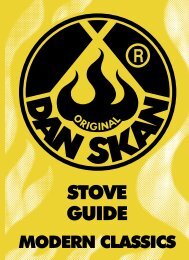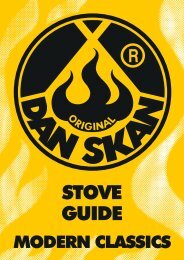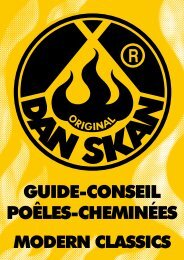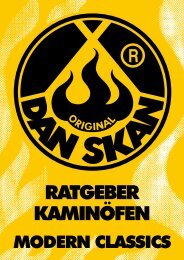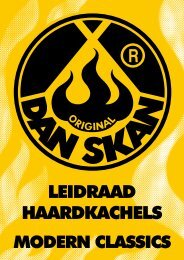STOVE GUIDE - DanSkan
STOVE GUIDE - DanSkan
STOVE GUIDE - DanSkan
You also want an ePaper? Increase the reach of your titles
YUMPU automatically turns print PDFs into web optimized ePapers that Google loves.
EN TESTING<br />
CE CERTIFICATE AND SAFETY TESTS<br />
NATURE OF THE TEST<br />
All DAN SKAN stoves including the new MODERN LINE range<br />
have CE conformance certificates having successfully passed<br />
all the requirements of the European test EN13240.<br />
The test results are significantly lower in all areas than the<br />
European limit values as well as the certification programme<br />
DIN Plus and the Stage II of the strict German BImSchV. Other<br />
tests included the Austrian norm 15aB-VG with the demands<br />
of the FGV from the Steirmark, the norm concerning safety<br />
measurements for small burning sections (BMfWA), the<br />
demand of the BStV of the cities Munich and Regensburg and<br />
others as well as the Swiss norm of the Association of Cantonal<br />
Fire Insurance Companies.<br />
PRIORITY RESULTS<br />
1. Particulate Matter<br />
The fine particle emissions in the flue gases at nominal heat output<br />
(EN kW) are below 29 mg/Nm³ at 13 % O 2<br />
2. Carbon Monoxide<br />
The concentrations in the exhaust at nominal heat output are below<br />
Vol 0.10 % at 13 % O 2<br />
3. Efficiency<br />
The efficiencies are well above the limit values specified in standards<br />
being >80 %<br />
TEST CONDITIONS AND RESULTS<br />
The test conditions and results are based on a standard sized<br />
chimney with a delivery pressure of 12 Pascal (Pa).<br />
The combustion air was regulated in the same way as a stove<br />
owner would by using the intelligent automatic bimetal system<br />
and the wood logs used had a residual moisture content of less<br />
than 15 %.<br />
For DAN SKAN owners this means that the highest performance<br />
can easily be achieved outside the test laboratory!<br />
TOP FIRE WITH WOOD<br />
For the best results place your wood logs across each other<br />
in the fire chamber and ignite from the top of the stack = TOP<br />
FIRE! Gas and debris escape mainly from the cut ends of the<br />
logs so keep these away from the glass surface.<br />
A quick starting fire is very important in eliminating smoke and<br />
emissions and starting the flue draught cycle.<br />
DAN SKAN stoves are started with the riddle grate closed and<br />
the pull control open. The starting fire is prepared by placing<br />
several logs side to side on top of each other and then placing<br />
a layer of kindling on top of these.<br />
DAN SKAN stoves start with air (secondary and tertiary) delivered<br />
over the top of fire for clean and efficient combustion.<br />
After the first refuelling with logs (between 1 and 2 hours) the<br />
fire chamber and the flue system will now be hot enough to<br />
provide the correct negative pressure in the chimney stack for<br />
effective operation.<br />
SAFETY AND CARE<br />
Be sure to keep an eye on the stove during the start-up phase<br />
especially if you leave the stove door ajar to provide extra initial<br />
combustion air. We recommend good proprietary fire lighters to<br />
start the fire – never use methylated spirit, petrol or other inflammable<br />
liquids. Never leave matches on or near the stove.<br />
Do not leave it too late to refuel your stove. Always add wood to<br />
the fire when there are still enough small flames in the chamber<br />
to help ignite them quickly.<br />
If you refill when there are only dying embers this will significantly<br />
slow the up-draught and the wood will also be slow to ignite.<br />
Remember it is flames that produce an effective up-draught and<br />
also ensure unproblematic opening of the stove door to minimise<br />
fly-ash and smoke entering the room. Opening the stove door<br />
very slowly also helps avoid these problems.<br />
With the DAN SKAN automatic system closing the air supply as<br />
the fire burns down you may be left with some charcoal embers<br />
– this is a clear sign of a very economical and effective air supply.<br />
The charcoal embers will then provide a very good ‘foundation’<br />
for the next firing.<br />
86<br />
AIR SUPPLY TO THE ROOM<br />
There are strict legal requirements for maintaining a sufficient supply<br />
of air to the room to ensure the health and safety of the room‘s<br />
occupants. These will be laid out in local, national and European<br />
building regulations and should be adhered to at all costs.<br />
As stoves will take some or all of their combustion air from the<br />
room they are located in and the stove owner must ensure that<br />
there is a safe uninterrupted supply of air for both the stove<br />
and anyone using the room. With modern day energy saving<br />
measures and well sealed floors, doors and windows some<br />
rooms can be virtually air-tight. To offset this and to conform<br />
with regulations a dedicated non-closable air vent or external<br />
air supply direct to the stove may need installing and you<br />
should consult your approved stove installer to advise you.<br />
As a guideline the combustion air needed for a DAN SKAN<br />
stove is:<br />
< 4 kW burning = < 12 m³/hour<br />
< 6 kW burning = < 15 m³/hour<br />
< 8 kW burning = < 18 m³/hour<br />
EX-AIR OPERATION<br />
DAN SKAN stoves can be operated with an external or direct<br />
air supply to provide 100 % of the stove‘s combustion air<br />
requirements so that when burning they do not deplete the air<br />
in the room the stove is installed in.<br />
The conventional EX-AIR-1 system with its connection from the<br />
external air and the air in the room enables a pressure balance<br />
in the room the stove is installed in. The EX-AIR-2 system<br />
enables pre-heated combustion air because of the DAN SKAN<br />
patented AIRBox. With heat recovery systems (0kW houses or<br />
low-energy houses) the pressure in the room where the stove is<br />
to be installed should not be higher than 4 Pascal.<br />
DIBt TESTING<br />
Most of the MODERN LINE stoves have passed a strict new<br />
test at the respected RFF-Test Institute in Germany for<br />
approval by the important German Institute for Construction<br />
(Deutsches Institut Fuer Bauchtechnik).<br />
This tests the ‘stove burning independently with external air’<br />
and examines the CO-concentration (ppm) in the smoke and<br />
the leak rates (m³/h) with 10 Pa and after the stove has been<br />
subjected to thermal and mechanical stress. For example the<br />
stove’s door seal must pass certain ‘air tightness’ requirement<br />
after the door has been opened and closed a minimum of<br />
6,000 times.<br />
PERMITTED FUELS<br />
Permitted fuels include wood logs with a residual moisture content<br />
of no more than 18 % which should be cut into lengths between<br />
approximately 250 to 330 mm. The wood should be air-dryed.<br />
Approved smokeless fuels and brown coal briquettes are also<br />
permitted.<br />
The combustion of household waste, especially plastic, is not<br />
permissible as it could damage the stove or flue components<br />
and invalidate your warranties.<br />
SAFETY INSTRUCTIONS<br />
The burning of combustible materials releases energy which<br />
leads to intense heating of the external surfaces of the stove<br />
including the door handle. Care must be taken to avoid touching<br />
the stove without proper protection (for example heat resistant<br />
gloves or other protective aids). Never leave children unattended<br />
in the room where your stove is being operated. Ensure that<br />
children are aware of the potential danger and make sure that<br />
they keep clear of the stove when it is in operation. Where<br />
children, the elderly or the infirm are present always use an<br />
approved safety fireguard to prevent accidental contact with<br />
the stove. An approved carbon monoxide detector should be<br />
fitted in the same room as the stove. It should be powered by a<br />
battery designed for the working life of the alarm. Please note<br />
this is now a requirement under UK Building Regulations.



